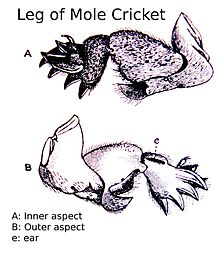Fossorial
[4] The oldest example of burrowing in synapsids, the lineage which includes modern mammals and their ancestors, is a cynodont, Thrinaxodon liorhinus, found in the Karoo of South Africa, estimated to be 251 million years old.
[1] There are six major external modifications, as described by H. W. Shimer in 1903,[5] that are shared in all mammalian burrowing species: Other important physical features include a subsurface adjusted skeleton: a triangularly shaped skull, a prenasal ossicle, chisel-shaped teeth, effectively fused and short lumbar vertebrae, well-developed sternum, strong forelimb and weaker hind limb bones.
[5] Due to the lack of light, one of the most important features of fossorial animals are the development of physical, sensory traits that allow them to communicate and navigate in the dark subsurface environment.
Considering that sound travels slower in the air and faster through solid earth, the use of seismic (percussive) waves on a small scale is more advantageous in these environments.
The Namib Desert golden mole (Eremitalpa granti namibensis) can detect termite colonies and similar prey underground due to the development of a hypertrophied malleus.
[7] The most likely explanation of the actual transmission of these seismic inputs, captured by the auditory system, is the use of bone conduction; whenever vibrations are applied to the skull, the signals travel through many routes to the inner ear.
Many fossorial and sub-fossorial mammals that live in temperate zones with partially frozen grounds tend to hibernate due to the seasonal lack of soft, succulent herbage and other sources of nutrition.
[12] One important impact on the environment caused by fossorial animals is bioturbation, defined by Marshall Wilkinson as the alteration of fundamental properties of the soil, including surface geomorphic processes.


